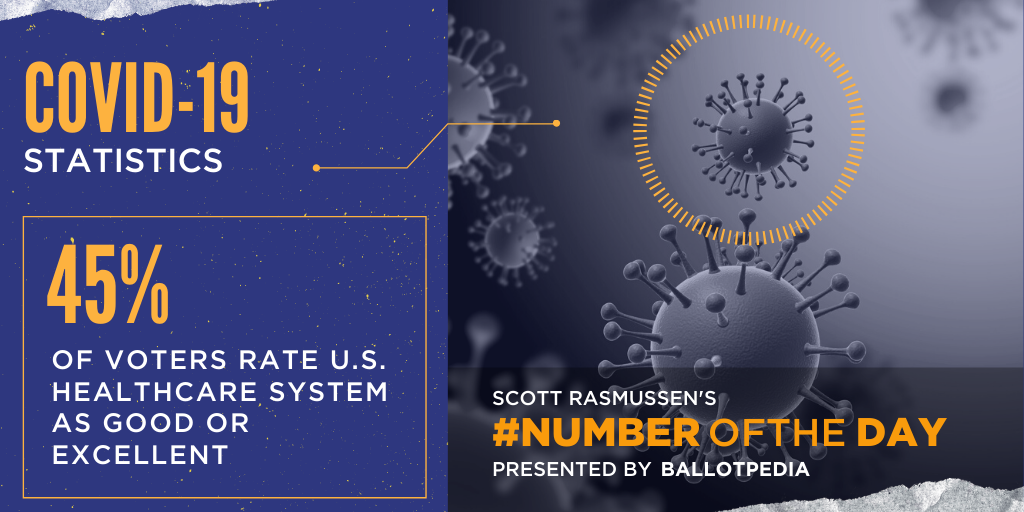| This is our daily update on how federal, state, and local officials are planning to set America on a path to recover from the coronavirus pandemic.
Each day, we:
- Track the status of reopening in all 50 states.
- Compare the status of one industry or activity across the country.
- Provide in-depth summaries of the latest reopening plans.
- Give you the latest stories on other reopening plans and ideas.
Want to know what happened yesterday? Click here.
The next two days
What is reopening in the next two days? Which stay-at-home orders will expire?
May 28:
- New York (Democratic trifecta): New York’s statewide stay-at-home order is scheduled to expire on May 28. It will become the 29th state to end a stay-at-home order. After the stay-at-home order is lifted, New York City will remain on PAUSE, which will keep what it calls non-essential businesses closed, limit social gatherings, and require social distancing. All of New York’s other regions have started the process of reopening.
May 29:
- District of Columbia: The nation’s capital will begin Phase One of its reopening plan on May 29, Mayor Muriel Bowser (D) announced on May 27. Phase One will still prohibit gatherings of more than 10 people and require social distancing and face coverings. Retail curbside and delivery will be allowed, along with appointment-only services at barbershops and salons. Restaurants and mixed-use facilities that serve food may open for outdoor dining.
- Illinois (Democratic trifecta): The state’s stay-at-home order will expire on May 29. It will become the 30th state to end a stay-at-home order. For more on Illinois’ reopening, see today’s Featured Plan.
- Nevada (Democratic trifecta): On May 26, Gov. Steve Sisolak (D) announced that the state would enter phase two of its reopening plan on May 29. Gyms will be allowed to open at 50% capacity and with social distancing guidelines. Bars that do not serve food will be allowed to reopen at 50% capacity, with table service only. Barbershops and salons may reopen with sanitation and social distancing guidelines. Places of worship will be allowed to reopen with an attendance limit of 50 people and social distancing guidelines.
- Texas (Republican trifecta): On May 26, Gov. Greg Abbott (R) announced that waterparks can reopen at 25% capacity on May 29. He also announced that food court dining areas in malls could reopen immediately.
- Vermont (divided government): On May 27, Gov. Phil Scott (R) announced he expects to increase the social gathering limit from 10 to 25 on May 29. Scott said he would provide details on when indoor dining at restaurants can resume and when museums can reopen at a later date.
- Virginia (Democratic trifecta): Gov. Ralph Northam (D) announced that beginning on May 29, everyone in the state over the age of 10 will be required to wear a face covering in indoor public areas. The requirement applies in grocery stores, entertainment establishments, train and bus stations, or any indoor spaces where groups of people cannot remain more than six feet apart. Also on May 29, the whole state will fall under Phase One of the reopening plan. Northern Virginia, Richmond, and Accomack County did not enter Phase One with the rest of the state on May 15 because of high rates of infections.
Since our last edition
Have any states opened? For a continually updated article on reopening status in all 50 states, click here. For our last edition, click here.
- Arkansas (Republican trifecta): A directive from the state Department of Health took effect on May 26 allowing bars to reopen. Bars may operate at 33% of seating capacity with social distancing guidelines for table service and bar service. Patrons must wear a mask until food or drink is served.
- California (Democratic trifecta): Gov. Gavin Newsom (D) announced that barbershops and salons could reopen on May 27 in the counties that had already progressed to Phase 2 of the state’s reopening plan. The state published guidance containing social distancing and sanitation protocols.
- Delaware (Democratic trifecta): Gov. John Carney (D) announced that the state’s short-term rental ban and the requirement that out-of-state travelers self-quarantine for 14 days will be lifted on June 1. Outdoor gatherings of up to 250 people will also be permitted on that date.
- New Mexico (Democratic trifecta): Gov. Michelle Lujan Grisham (D) announced that the state would permit outdoor dining at restaurants starting May 27. Indoor dine-in services remain prohibited.
- North Carolina (divided government): A bill that would permit bars to serve beverages outside, on a patio, or under a tent, cleared a Senate committee on May 26. Bars are not scheduled to reopen until Phase 3 of North Carolina’s reopening plan, scheduled to begin on June 26. The state entered Phase 2 on May 22. The bill moves to another committee before the full House and Senate may consider it. The House and Senate have Republican majorities, while the governorship is held by Roy Cooper, a Democrat.
- Washington (Democratic trifecta): Secretary of Health John Weisman approved three new counties to move into Phase 2 of the reopening plan, bringing the total number of counties in Phase 2 to 24. Gov. Jay Inslee (D) released updated rules for outdoor recreation, allowing zoos in counties that have moved into Phase 2 to reopen at 25% capacity.
Update on stay-at-home orders
Forty-three states issued orders directing residents to stay home except for essential activities and the closure or curtailment of businesses each state deemed nonessential. Seven states did not.
As of May 27, stay-at-home orders have ended in 28 states. Eighteen of those states have Republican governors and 10 have Democratic governors (including Wisconsin, where the state Supreme Court invalidated the stay-at-home order). Of the 15 states with active stay-at-home orders, one has a Republican governor and 14 have Democratic governors.
Here’s which stay-at-home orders have expired, and when the rest are scheduled to expire.
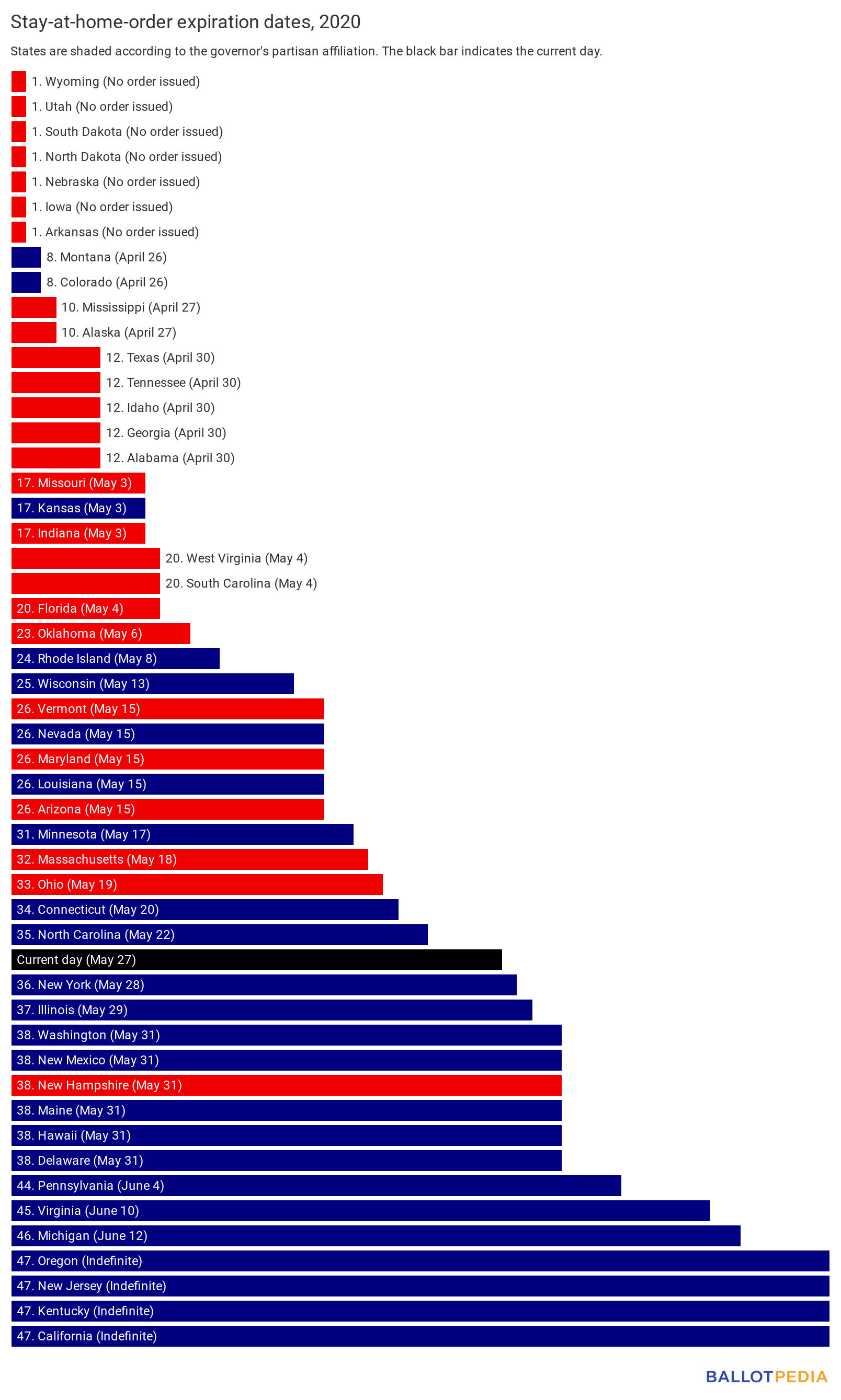
Tracking industries: Bars
All 50 states began to reopen in some way. Here, we give the status of one industry or activity across the states. Today’s question: in which states may you go out for a drink at a bar that does not serve food?
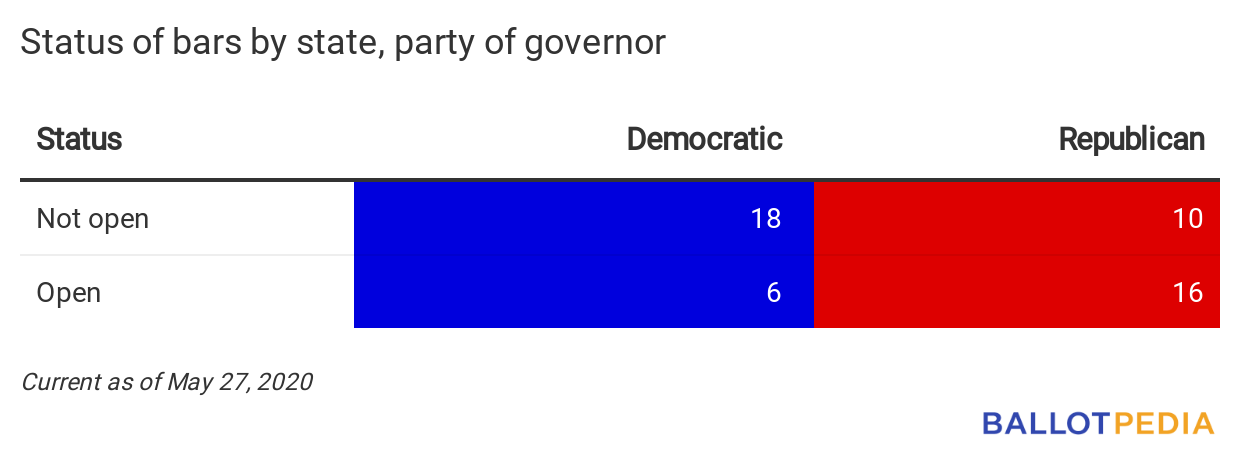 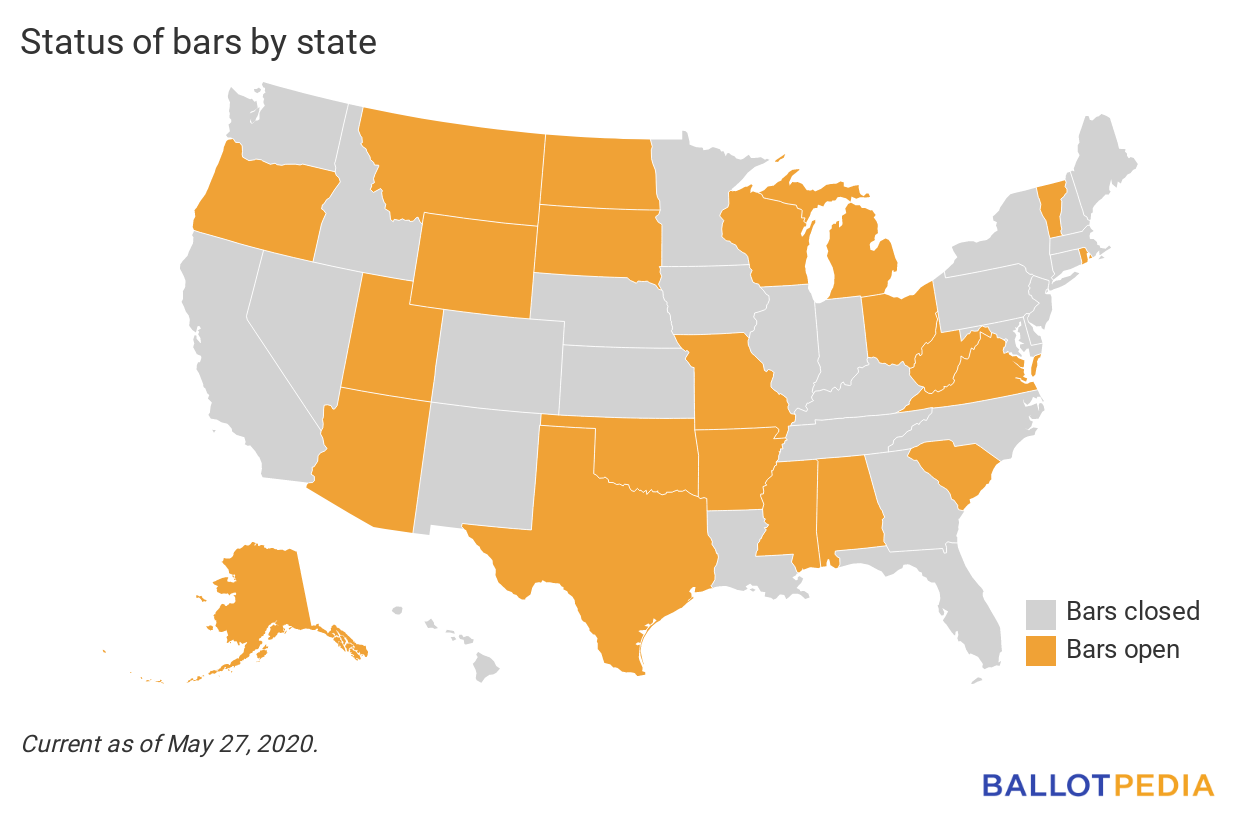
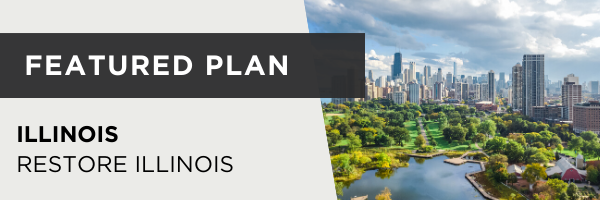
This is an in-depth summary of one of the latest reopening plans. Is there a plan you’d like us to feature? Reply to this email and let us know. Click here for previous editions and featured plans.
On May 5, Gov. J.B. Pritzker (D) announced “Restore Illinois,” a five-phase plan for reopening the state based on health metrics.
The plan divides the state into four regions that may move between phases at different times. Counties may not move through phases at a different rate than their regions. Criteria for moving from one phase to the next include case rate, testing capacity, hospital capacity, and contact tracing capacity.
The governor’s office stated:
| “ |
The plan is based upon regional healthcare availability, and it recognizes the distinct impact COVID-19 has had on different regions of our state as well as regional variations in hospital capacity. The Illinois Department of Public Health (IDPH) has 11 Emergency Medical Services Regions that have traditionally guided its statewide public health work and will continue to inform this reopening plan. For the purposes of this plan, from those 11, four health regions are established, each with the ability to independently move through a phased approach. |
” |
As of May 27, all regions are in Phase 2. On May 26, Pritzker said all regions were on track to enter Phase 3 on May 29. Phase 3 is set to last at least 28 days, as one of the criteria for advancing to Phase 4 is “[n]o overall increase (i.e. stability or decrease) in hospital admissions for COVID-19-like illness for 28 days.” Details on each phase are below.
Local governments may implement stricter requirements than the state. On May 26, Chicago Mayor Lori Lightfoot announced the city is preparing to move to Phase 3 of its reopening plan in early June. Chicago is the third-largest city in the U.S. with a population of 2.7 million.
Context
- Pritzker issued a stay-at-home order, effective March 21, ordering individuals to stay home except for essential activities and nonessential businesses to close for most on-site work. Elderly people and those who are vulnerable as a result of illness are advised to take extra precautions. The order limits essential gathering sizes to 10 and contains social distancing requirements for all operating businesses and individuals in shared and outdoor spaces. The order was set to expire on April 7. On April 1, Pritzker extended the order until April 30. On April 30, Pritzker modified and extended the order, allowing retail to open for delivery and curbside pickup and requiring individuals to wear face coverings in public when they cannot maintain six feet of social distance. The order expires on May 29.
- As of May 27, the Illinois Department of Public Health website reported 113,195 confirmed COVID-19 cases and 4,923 deaths. Illinois’ estimated population as of July 2019 was 12.7 million. Illinois had 893.3 cases per 100,000 residents and 38.8 deaths per 100,000 residents.
- Illinois is a Democratic trifecta, with a Democratic governor and Democratic majorities in both chambers of the state legislature.
Plan details
Phase 1 (Rapid spread)
Individual/social
- Essential gatherings, such as religious services, of 10 or fewer permitted. No nonessential gatherings of any size allowed.
- Nonessential travel discouraged
- Walking, hiking, and biking permitted
Businesses/sectors
- Employees of nonessential businesses required to work from home except for Minimum Basic Operations
- Bars and restaurants open for delivery, pickup, and drive-through only
- State parks closed
- Childcare in groups of 10 or fewer for essential workers
- Healthcare: Emergency procedures and COVID-19 care only
Moving to the next phase
Case and capacity: New case growth slowing and surge capacity in adult medical and surgical beds, ICU beds, and ventilators available
Testing: Ability to perform 10,000 tests per day statewide and testing available in the region for symptomatic healthcare workers and first responders
Phase 2 (Flattening)
Individual/social
- Face coverings must be worn when physical distancing not possible
- Essential gatherings, such as religious services, of 10 or fewer permitted. No nonessential gatherings of any size allowed.
- Nonessential travel discouraged
- Boating and fishing permitted (with IDPH safety guidance)
Businesses/sectors
- Nonessential retail open for delivery and curbside pickup
- Select state parks open (with IDPH safety guidance)
- Golf courses open (with IDPH safety guidance)
- Elective procedures allowed if IDPH criteria are met
Moving to the next phase
Case and capacity: At or under a 20% positivity rate and increasing no more than 10 percentage points over a 14-day period, no overall increase in hospital admissions for COVID-19-like illness for 28 days, and available surge capacity of at least 14% of ICU beds, medical and surgical beds, and ventilators
Testing: Testing available for all patients, first responders, healthcare workers, people with underlying conditions, and congregate living facility residents and staff
Tracing: Begin contact tracing and monitoring within 24 hours of diagnosis
Phase 3 (Recovery)
Individual/social
- Gatherings of 10 or fewer allowed (subject to change)
- Continued requirement of face masks in public
- Travel following IDPH and CDC guidance
Businesses/sectors
- Manufacturing that can operate with social distancing (with IDPH safety guidance)
- “Employees of ‘non-essential’ businesses are allowed to return to work with IDPH approved safety guidance depending upon risk level, tele-work strongly encouraged wherever possible; Employers are encouraged to provide accommodations for COVID-19-vulnerable employees”
- Barbershops and salons open (with IDPH safety guidance)
- Health and fitness clubs can open for outdoor classes and one-on-one personal training (with IDPH safety guidance)
- Retail, with capacity limits, face coverings, and IDPH guidance
- State parks open
- Healthcare providers open (with IDPH safety guidance)
- Limited childcare and summer programs (with IDPH safety guidance)
- Bars and restaurants open for outdoor dining and drinking (with tables six feet apart and additional guidelines)
- Offices (50% of normal capacity and additional guidelines)
Moving to the next phase
Case and capacity: Criteria are the same for moving from Phase 3 to Phase 4 as for moving from Phase 2 to Phase 3.
Testing: Available in a region regardless of symptoms or risk factors
Tracing: Contact tracing and monitoring to begin within 24 hours of diagnosis for more than 90% of cases in a region
Phase 4 (Revitalization)
Individual/social
- Gatherings of 50 or fewer permitted (subject to change)
- Travel following IDPH and CDC guidance
- All outdoor recreation allowed
Businesses/sectors
- Schools open (with IDPH safety guidance)
- Childcare/summer programs open (with IDPH safety guidance)
- All healthcare providers open
- All manufacturing open (with IDPH safety guidance)
- “‘Non-essential’ businesses: All employees return to work with IDPH approved safety guidance; Employers are encouraged to provide accommodations for COVID-19-vulnerable employees”
- Bars and restaurants open with capacity limits and IDPH safety guidance
- Barbershops, salons, and spas with capacity limits and IDPH safety guidance
- Health and fitness clubs with capacity limits and IDPH safety guidance
- Cinemas and theaters with capacity limits and IDPH safety guidance
- Retail with capacity limits and IDPH safety guidance
Moving to the next phase
“Vaccine, effective and widely available treatment, or the elimination of new cases over a sustained period of time through herd immunity or other factors.”
Phase 5 (Illinois Restored)
Individual/social
- Gatherings of all sizes can resume
Businesses/sectors
- “All sectors of the economy reopen with businesses, schools, and recreation resuming normal operations with new safety guidance and procedures”
- Conventions, festivals, other large events allowed
Uniform guidelines for businesses, industries, and nonprofits
Businesses, industries, and nonprofits must follow common guidelines in addition to sector-specific guidelines. An abbreviated list of common guidelines is below.
Click here for a complete list of guidelines.
Click here for a toolkit with posters, signage, checklists, and more from the Illinois Department of Commerce and Economic Opportunity and the Illinois Department of Public Health.
| “ |
GENERAL HEALTH
i. Minimum guidelines
- All employees who can work from home should continue to do so
- Employees should wear face coverings over their nose and mouth when within 6-ft. of others (cloth masks preferred). Exceptions may be made where accommodations are appropriate – see IDHR’s guidance.
- Social distance of at least 6-ft. should be maintained between non-household individuals unless participating in activities permitted under Phase III guidelines
- Employer should provide hand washing capability or sanitizer to employees and if applicable, customers
- Frequent hand washing by employees, and an adequate supply of soap/ paper towels and/or disinfectant/ hand sanitizer should be available
|
” |
| “ |
HR AND TRAVEL POLICIES
i. Minimum guidelines
- All employees should complete health and safety training related to COVID-19 when initially returning to work. Resources to design a training are posted on the DCEO Restore Illinois guidelines website
- Employers should continue to limit all non-essential business travel
- If employee must travel, employee should follow CDC considerations to protect themselves and others during trip
- Employees should not report to, or be allowed to remain at, work if sick or symptomatic (with cough, shortness of breath or difficulty breathing, fever of 100.4 degrees or above, chills, muscle pain, headache, sore throat, new loss of taste or smell, or other CDC-identified symptoms), and sick or symptomatic employees should be encouraged to seek a COVID-19 test at a state or local government testing center, healthcare center or other testing locations …
|
” |
| “ |
HEALTH MONITORING
i. Minimum guidelines
- Employers should make temperature checks available for employees and encourage their use. Employers should post information about the symptoms of COVID-19 in order to allow employees to self-assess whether they have any symptoms and should consider going home.
- All employers should have a wellness screening program. Resources outlining screening program best practices are posted on the DCEO Restore Illinois guidelines website
- Employer should conduct in-person screening of employees upon entry into workplace and mid-shift screening to verify no presence of COVID-19 symptoms
- If employee does contract COVID-19, they should remain isolated at home for a minimum of 10 days after symptom onset and can be released after feverless and feeling well (without fever-reducing medication) for at least 72 hours OR has 2 negative COVID-19 tests in a row, with testing done at least 24 hours apart …
|
” |
Sector-specific guidelines
As of May 27, the Illinois Department of Commerce and Economic Opportunity released guidelines for 10 sectors set to reopen in Phase 3.
Click here to view sector-specific guidance.
Reactions
- State Senate Minority Leader Bill Brady (R) said, “Ensuring the public’s health remains our top priority, and any loss of life as a result of this deadly disease is a tragedy. While it is important to have a plan that gives us hope, we need to look at it in greater detail. However, the question of why Illinois needs to maintain a 28-day window before moving between phases, as opposed to the 14-day recommendation of Dr. Fauci, which is what states like New York are using in their reopening plans, needs to be answered.”
- Illinois Comptroller Susana Mendoza (D) said, “I want to thank Gov. Pritzker for his carefully-thought-out, science-based approach to restoring Illinois, region by region. I appreciate the leadership, concern and compassion he has demonstrated to the entire state during this awful and deadly COVID-19 coronavirus pandemic. The governor’s Restore Illinois plan provides all of us with a predictable road map for reopening Illinois.”
- State Rep. Mike Murphy (R) said, “I’m glad the Governor has finally heard our calls for a regional approach to addressing COVID-19 and a plan for safely reopening our state. The unintended consequences of the one size fits all approach has been devastating for families and small businesses across central Illinois. … However, the timetable for implementation in different regions, the ability of informed local officials to be a part of the decision-making process, and the vagueness of requirements leave too many unanswered questions. Saying it will be a regional approach is one thing, but if the decisions are still being made by someone from outside our region with limited local consultation, then we still risk being the victim of a one size fits all cure that does more harm than the virus itself.”
- Mark Denzler, president and CEO of the Illinois Manufacturers’ Association, said, “Illinois’ economy has been devastated by this pandemic, which has put at risk not just lives but also livelihoods. While many manufacturers across the state have continued operating to produce needed medical products, safe and nutritious food, and equipment for our first responders, others are eager to start production and put people back to work. … We appreciate Gov. Pritzker’s focus on a plan that puts Illinois on a path to safely re-opening. Manufacturers are ready to unleash their full economic might to help restore our state’s economy.”
|
